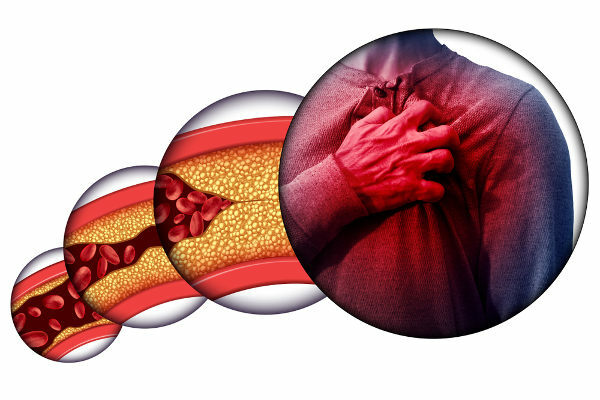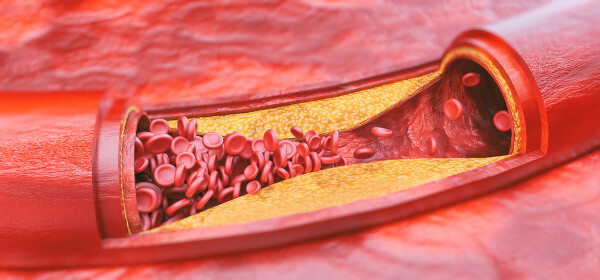atherosclerosis it is a health problem of multifactorial origin that is characterized by the accumulation of lipids, inflammatory cells and other elements in the wall of the arteries, which leads to narrowing and stiffening of these vessels. It occurs mainly in the intima layer (innermost layer) of small and medium-caliber arteries. Next, we'll find out more about atherosclerosis, which is a serious problem related to the development of a number of other problems, such as heart attack and strokes.
Know more: 10 leading causes of death in the world
How does atherosclerotic plaque formation occur?

According to the V Brazilian Guideline on Dyslipidemia and Prevention of Atherosclerosis, the formation of atherosclerotic plaque occurs as follows. The atherosclerotic plaque starts its formation when there is a aggression to the artery endothelium. This aggression can occur due to several factors, such as high blood pressure, smoking and increased levels of cholesterol and triglycerides in the blood.
As a result, the increased intimal permeability to lipoproteins, which causes these to be retained in the subendothelial space. Low-density lipoprotein particles (LDL) then undergo oxidation, which makes them immunogenic, that is, capable of generating a response from the Imune system. It is noteworthy that the deposition of lipoproteins is proportional to their concentration in the plasma.
In addition, another consequence of aggression to the endothelium is the emergence ofleukocyte adhesion molecules, that happens in response to the presence of oxidized LDL. Leukocyte adhesion molecules attract monocytes and lymphocytes, two types of leukocytes also known as white blood cells.

You monocytes they move towards the subendothelial space, differentiate into macrophages and phagocytose oxidized LDL. These macrophages are then called foam cells. Activated macrophages act by amplifying inflammation and degrading tissue and collagen components due to the secretion of cytokines and proteolytic enzymes, respectively. It is noteworthy that other inflammatory cells can participate in the plaque formation process.
Inflammation mediators they are responsible for stimulating the proliferation and migration of smooth muscle cells to the intima region. These cells start to produce cytokines, growth factors and extracellular matrix, which will guarantee the formation of the fibrous cap of the atherosclerotic plaque.
Do not stop now... There's more after the advertising ;)
Risk factors for the development of atherosclerosis
Atherosclerosis has some risk factors, including genetic and environmental factors. Some examples are:

Inadequate nutrition;
Genetic abnormalities in lipoprotein metabolism;
Diabetes;
Dyslipidemia (presence of high levels of lipids in the blood);
Aging;
Family history;
Obesity;
High pressure;
Sedentary lifestyle;
Sex (men are at increased risk of developing the problem);
Smoking.
Risk factors can be classified into two large groups: modifiable and the unmodifiable. The modifiable ones are those that can be prevented, that is, they can be controlled, as in the case of hypertension, smoking and high cholesterol. The non-modifiable ones are related to the inheritance of each individual and there is no control over them. These factors include family history, aging and gender, for example.
Read more: Risks of cigarette use
atherosclerosis symptoms
Atherosclerosis is a problem that can be silent, being discovered, many times, only after the occurrence of some complication. The symptoms caused by atherosclerotic plaque formation depend on where it will form.
chest pains, for example, may indicate the formation of a plaque in an artery that nourishes the heart. Another symptom is the pain in lower limbs when walking, when plaques form in this region. When arteries with atherosclerotic plaques are located in the brain, they can be responsible, for example, for dizziness.
Consequences of atherosclerosis
The formation of atherosclerotic plaques is responsible for triggering the narrowing and stiffening of the arteries. This narrowing can lead to a reduced blood flow in the vessel and even its complete obstruction.
With the lack or reduction of blood flow, reduces the availability of oxygen and nutrients for a given area irrigated by the vessel in question. Thus, atherosclerosis can compromise the functioning of some important structures in the body, being responsible for causing problems such as strokes, heart attack and even sudden death.
Know more:infarction
Atherosclerosis treatment

Treatment of atherosclerosis aims to ensure that blood flow is restored to the affected sites. To achieve this goal, the physician may choose: treatment with medicines, such as antiplatelet agents and vasodilators; catheter-based procedures, such as balloon angioplasty (small balloons are placed and inflated to expand the area that has the reduced diameter); and placement of stent (kind of mechanical support that guarantees the opening of the vessel) or surgical procedures.
Prevention of atherosclerosis
The prevention of atherosclerosis is done mainly with the adoption of healthy lifestyle habits. Here are some tips that can help prevent this problem:
Controlling blood pressure;
Controlling diabetes;
Maintain proper weight. Obese or overweight people should reduce weight;
Do not use cigarettes;
Practice physical activities regularly;
Have a balanced diet with low salt and fat content.
By Ma. Vanessa Sardinha dos Santos
Would you like to reference this text in a school or academic work? Look:
SANTOS, Vanessa Sardinha dos. "Atherosclerosis"; Brazil School. Available in: https://brasilescola.uol.com.br/saude/aterosclerose.htm. Accessed on June 27, 2021.

